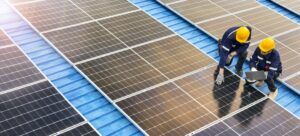Technology has helped us make our personal and work lives more efficient, but what about our cities? From parking to street lighting to urban planning, data analytics, mobile phones, and the Internet of Things (IoT) are changing the way we design and build today’s city’s spaces.
The concept of a “smart city” is nothing new, however the concept is increasingly being written into codes and adopted by cities big and small. As McKinsey pointed out in a recent study of smart city tech deployment, younger people are more accepting of technology in their lives and are more willing than older generations to use these tools.
As a building company, highlighting the ways you support smart city tech can help set you apart from the competition. In this post we explore aspects of the smart city and how you can better market to developers and communities looking to get smart with future development.
What is a Smart City?
Smart cities combine traditional infrastructure, urban planning and zoning, with technology to create urban environments that are environmentally sustainable and beneficial for people and businesses, too. This could include using vehicle and pedestrian traffic data to find a new spot for greenspaces that would reduce ambient summer temps with additional trees and vegetation, lower air pollution with less traffic and encourage walkability.
Oher smart city innovations could be motion-detecting street lights, electric buses, and zoning that allows for denser development. The key to smart cities is including data analytics in development decisions that meet the needs of many people.
How to Create a Smart City
Communities are changing to work smarter, not harder to provide services to residents and be more connected, from responding to traffic accidents to building more energy efficient buildings. This includes:
- Helpful technology and insights – The connected nature of our world makes it easier for people to make smarter choices about transportation, housing, and energy use. For example, smart–park apps tell people where to find open spots, reducing the time spent circling the block, while digital thermostats let people turn down the heat or AC when away from home with just a few clicks.
- Zoning and building regulations – Government has stepped up to play a role in building more efficient cities. Clean technology and building supplies like rooftop solar and sustainable building materials make it easier to build more efficient homes and make efficiency upgrades.
- Solar tax credits – Legislative policy has been another path for those pursuing smart cities of the future. The Inflation Reduction Act of 2022 helped usher in a number of smart regulations, and launched a solar boom, making solar installations more affordable for homeowners, communities and businesses.
- Walkable cities, better fleet management – Making cities more walkable will improve health, reduce air pollution and reduce energy consumption. With more cities exploring ways to reduce vehicle traffic, companies can rethink operations with fleet management software that optimizes fleet use.
Marketing Your Smart Cities Services and Tech
Making our cities smarter won’t happen overnight. Companies can create a competitive advantage by showing up as a leader during this transition.
What does that look like?
It begins with talking about sustainability and smart cities in a positive way in your marketing materials, to developers, and elected officials at the local and state level. Whenever you meet with one of these stakeholders, talk about how your company and processes advance these goals.
To start positioning your company as a thought leader in sustainability and smart city development, review your existing messaging and marketing materials. We recommend starting with:
Website
Even though the smart city concept has been around for a while, there are still many who don’t even know the basics. Create a Smart Cities 101 page on your company website to be the first place people in your area come to on this topic. It’s great for showing thought leadership and for getting more traffic to your site via SEO.
Social Media
A steady beat of smart city content is a great way to establish your company’s role as a sustainability leader. Aim for “Did you know…?” style posts, calls-to-action on changing local zoning, and other pro-sustainability content one to two times a week.
Email
Use email to increase awareness of your expertise and commitment to smart city policies. Point to recent smart development projects your company worked on, public meetings you’ve attended on smart city topics, and any content you create on the topic. Leverage stats in sustainability reports from local government and nonprofits to further show off your expertise.
Prove You’re a Smart City Leader
Construction isn’t always an industry associated with cutting edge tech, but the smart cities of the future will require tech savvy. Showing that you’re a company that’s comfortable with tech, whether that’s analyzing data or installing IoT tech, you can differentiate yourself from competition that’s slow to adopt these tools.
In addition, having a clear marketing strategy that’s true to your company and its sustainability goals will help you reach more people and in a more authentic way.



